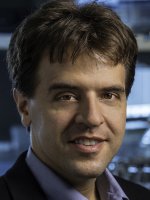Optical deconstruction of fully-assembled biological systems
Marshall W. Nirenberg Lecture | to

Karl Deisseroth, M.D., Ph.D.
Investigator, Howard Hughes Medical Institute
D.H. Chen Professor of Bioengineering and of Psychiatry and Behavioral Sciences
Stanford University
Dr. Deisseroth, a practicing psychiatrist, employs medications and interventional brain-stimulation techniques to treat patients with psychiatric disease. He led the development of optogenetics: the integration of genetics and optics to achieve gain- or loss-of-function of well-defined events in defined cell types within intact biological systems. He also led the development of CLARITY, a chemical engineering-based method for transforming biological systems by creating a tissue-hydrogel hybrid, to allow full transparency and accessibility to molecular labels without slicing or sectioning. CLARITY enables high-throughput whole-brain analysis of wiring and fine structure without disassembly. He has also used optogenetics and CLARITY to investigate Parkinsonism, anxiety, social dysfunction, depression, and other neuropsychiatric disease symptoms. Dr. Deisseroth is also the director of undergraduate education in bioengineering at Stanford, teaches graduate and undergraduate courses, provides education and training in optogenetics and CLARITY, and freely distributes and supports tools and expertise to thousands of scientists worldwide.
Summary
Dr. Deisseroth’s lecture will report on the development of optogenetics and CLARITY technologies. In the optogenetics domain, he will discuss strategies for targeting microbial opsins and light to meet the challenging constraints of the freely-behaving mammal, newly engineered microbial opsin genes spanning a range of optical, kinetic, and ion permeability properties, high-speed behavioral and neural activity-readout tools compatible with real-time optogenetic control, and the application of these tools to develop circuit-based insights into anxiety, depression, and motivated behaviors. Dr. Deisseroth will also discuss advances in the CLARITY technology that accelerate the extraction of information from intact biological tissue (mouse and human brain tissue) that has been transformed resulting in a transparent tissue-hydrogel that preserves and makes accessible, structural and molecular information for visualization and analysis. Together these complementary approaches can be used to probe disease mechanisms as well as the structure of the nervous system.
This page was last updated on Wednesday, August 11, 2021